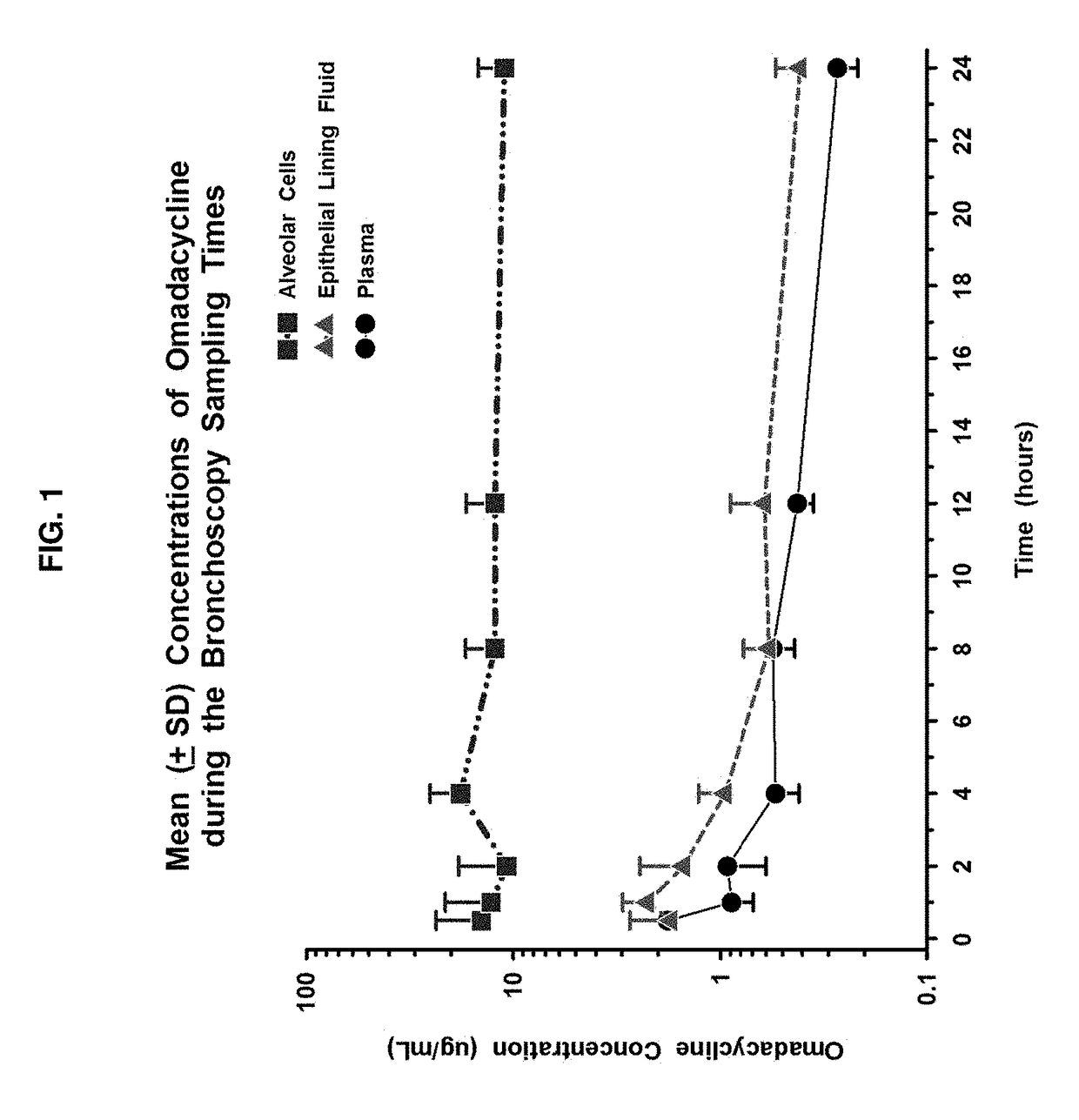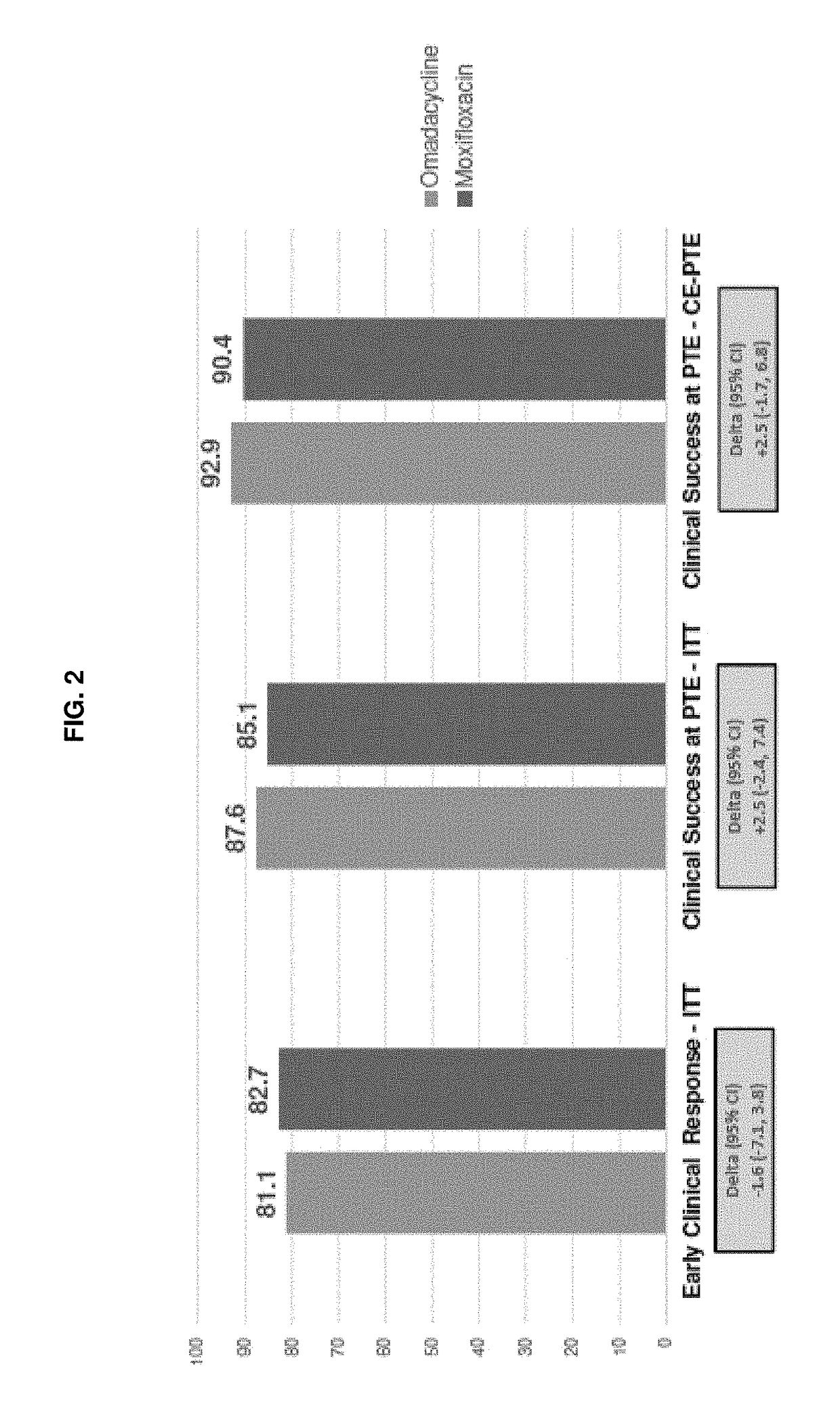9-Aminomethyl Minocycline Compounds And Use Thereof In Treating Community-Acquired Bacterial Pneumonia (CABP)
- Summary
- Abstract
- Description
- Claims
- Application Information
AI Technical Summary
Benefits of technology
Problems solved by technology
Method used
Image
Examples
example 1
an Open-Label, Parallel Group, Multiple IV Dose Study to Assess Intra-Pulmonary Steady-State Concentrations of Compound 1 and Tigecycline in Healthy Adult Subjects
[0204]To be effective in lower respiratory tract infections (RTI), an antibiotic must attain adequate concentrations in respiratory tissue to affect respiratory pathogens. Both extracellular and intracellular pathogens may cause infection, and therefore extracellular and intracellular concentrations of antibiotics must be adequate to cover all of the pathogens. The concentration of antibiotic in bronchial mucosa provides a reliable guide to bronchial penetration of the drug and may be a better predictor of clinical efficacy than serum levels for treatment of bronchitis and bronchopneumonia.
[0205]Epithelial lining fluid (ELF) and alveolar cells (AC), including mostly alveolar macrophages (AM), have been advocated as important infection sites for common extracellular and intracellular pathogens, respectively. Direct measurem...
example 2
Effect of Food on the Bioavailability of Omadacycline in Healthy Volunteers
[0317]Compound 1 (9-[(2,2-dimethyl-propyl amino)-methyl]-minocycline) is a first-in-class aminomethylcycline antibiotic that is characterized by improved in vitro antimicrobial activity (Honeyman et al, Antimicrob Agents Chemother. 59:7044-7053, 2015).
[0318]Phase 3 studies have concluded with Compound 1 as oral and intravenous (IV) monotherapy in patients with acute bacterial skin and skin structure infection (ABSSSI). During the development process, oral Compound 1 formulations have evolved from free-base in a capsule through a series of tablet and salt formulations in order to optimize oral bioavailability while improving tolerability. The current phase 3 tablet formulation is the tosylate salt of Compound 1, which has been shown to have an absolute bioavailability of 34.5% when administered under fasting conditions. The primary objective of this study was to evaluate the relative bioavailability of a singl...
example 3
A Phase 3 Randomized, Double-Blind, Multi-Center Study to Compare the Safety and Efficacy of Compound 1 IV / PO to Moxifloxacin IV / PO for Treating Adult Subjects with Community-Acquired Bacterial Pneumonia (CABP)
[0332]This study evaluates the safety and efficacy of intravenous (iv) and oral (po) Compound 1 as compared to iv and po moxifloxacin in the treatment of adults with CABP.
[0333]More specifically, the primary objective of this study is to demonstrate that Compound 1 100 mg iv every 12 hours (q12 h) for 2 doses, followed by 100 mg iv / 300 mg po once every 24 hours (q24 h) is non-inferior to moxifloxacin 400 mg iv / po q24 h in the treatment of adults with CABP. The secondary objectives are: to evaluate the safety of Compound 1 in the treatment of adult subjects with CABP in the Safety population; to evaluate the Clinical Response according to the identified causative pathogen; and to evaluate the pharmacokinetics (PK) of Compound 1 in adult subjects with CABP.
[0334]According to the...
PUM
 Login to View More
Login to View More Abstract
Description
Claims
Application Information
 Login to View More
Login to View More - R&D
- Intellectual Property
- Life Sciences
- Materials
- Tech Scout
- Unparalleled Data Quality
- Higher Quality Content
- 60% Fewer Hallucinations
Browse by: Latest US Patents, China's latest patents, Technical Efficacy Thesaurus, Application Domain, Technology Topic, Popular Technical Reports.
© 2025 PatSnap. All rights reserved.Legal|Privacy policy|Modern Slavery Act Transparency Statement|Sitemap|About US| Contact US: help@patsnap.com



